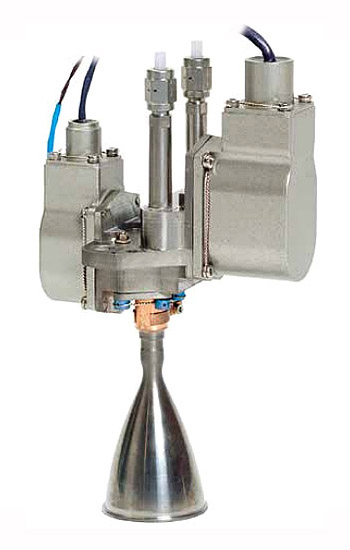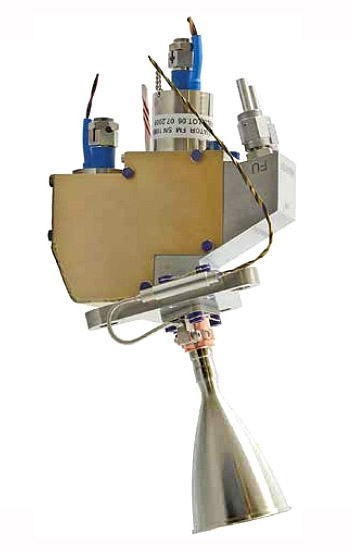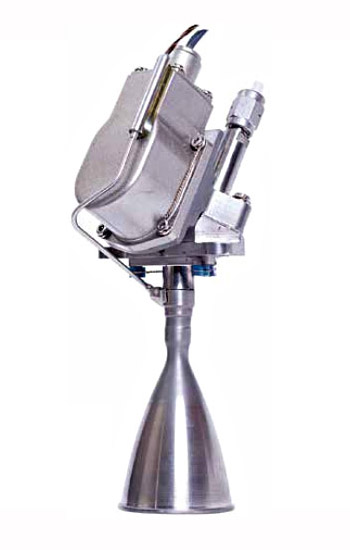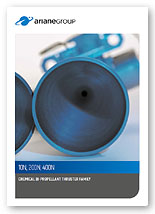10N Bipropellant Thrusters
For precision attitude, trajectory and orbit control of large satellites and deep space missions.
General Description
Amongst our range of bipropellant thrusters, the 10N 'work horse' thruster is specified for most applications.
Over 1000 of these thrusters have performed flawlessly in space with hundreds more allocated to future missions.
The 10N bipropellant thruster uses the storable propellants N2O4, MON-1 or MON-3 as oxidiser, and MMH as fuel.
The thruster is designed for both long term steady state and pulse mode operation and can function over a wide
pressure range in either pressure regulated mode or blow down mode.

10N Bipropellant Thruster
Type S10-18
with Dual Seat Valve
Dimensions:

10N Bipropellant Thruster
Type S10-26
with Dual Seat ArianeGroup Valve
Dimensions:

10N Bipropellant Thruster
S10-13
with Single Seat US Valve
Dimensions:
Thermal Control
If required, the thruster can be fitted with heaters and thermistors for thermal control.
Control Valve Options.
While providing identical performance, the 10N bipropellant thruster is available with a choice of three types
of propellant flow control valve:
Materials and Durability
The combustion chamber and nozzle is manufactured from a platinum alloy that requires no surface coating and
allows operational temperatures up to 1,500 °C (2,700 °F), thus enabling maximum thruster performance. The uncoated
surface is absolutely resistant against oxidation and is thus invulnerable to the application of test sensors as
well as millions of pulse cycles.
Systems Flow Rate Calibration
The thruster is provided with trimming orifices upstream of the propellant control valves. This feature allows
for individual adjustment of the propellant flow rate according to the systems design pressure.
- Thruster S10-13 with single seat, monostable, torque motor valve from a US supplier.
- Thruster S10-18 with dual seat valve, comprising an upstream latch valve and a downstream
monostable valve from a US supplier.
- Thruster S10-26 with dual seat valve, comprising an upstream latch valve and a downstream
monostable valve supplied by ArianeGroup, Germany.
When fitted with the ArianeGroup valve, the thruster becomes an all European product.
Characteristics
Metric Values
Imperial/US Values
Thrust, Nominal
10N
2.2 lbf
Thrust Range
6.0 to 12.5N
1.4 - 2.8 lbf
Specific Impulse at Nominal Point
292 s
Flow Rate, Nominal
3.50 g/s
Flow Rate, Range
2.30 to 4.20 g/s
Mixture Ratio, Nominal
1.60 to 1.65
Mixture Ratio, Range
1.20 to 2.10
Chamber Pressure, Nominal
9 bar
130 psi
Inlet Pressure Range
10 to 23 bar
145 - 335 psi
Throat Diameter (inner)
2.85 mm
0.11 inch
Nozzle End Diameter (inner)
35 mm
1.38 inch
Nozzle Expansion Ratio (by area)
150
Mass Thruster with Single Seat Valve
350 g
0.8 lb
Mass Thruster with Dual Seat Valve
650 g
1.5 lb
Chamber/Nozzle Material
Platinum / Rhodium alloy
Injector Type
Double Cone Vortex
Cooling Control
Film and Radiative
Propellants:
- Fuel
- Oxidiser
MMH
N2O4, MON-1, MON-3
Valve, Single Seat
Bipropellant torque motor valve
Valve, Dual Seat
Bipropellant torque or linear motor valve
Mounting Interface to Spacecraft
Valve flange with 3 feedthrough holes of 6.4 mm (¼") dia.
Tubing Interface
Per SAE AS4395E02, or welded
Valve Lead Wires
24 AWG per MIL-W-81381
Thruster Heater and Thermal Sensor
On request
Qualified longest single burn
8 Hours
Qualified Accumulated Burn Life
69 Hours
Qualified Cycle Life
1,000,000 cycles
Arabsat 4AR = Badr-6
2008

|
Bipropellant Thrusters
(PDF Brochure)
|
Bipropellant Thruster Brochure (pdf)
This brochure is available to
view
online from where it may be downloaded.
Get the latest version of the free Adobe Acrobat
Reader 
If you require the printed version of this brochure, or more detailed information about this product
please contact us.
See the complete list of our space propulsion
brochures available for download.




